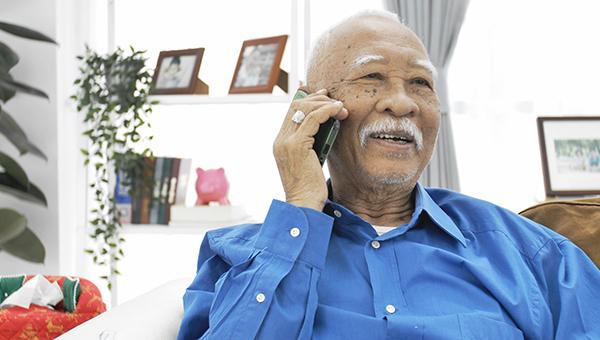HF Care Didn’t Suffer as Clinicians Turned to Telehealth in COVID-19
A hybrid model is emerging as the pandemic evolves, and quality-of-life scores may help triage who needs in-person visits.

Telehealth can enable clinicians to provide care for outpatients with heart failure (HF) without sacrificing outcomes, suggests the experience of a large US healthcare system during the COVID-19 pandemic.
Nearly 90% of clinic visits for HF in the Saint Luke’s Health System were conducted via telehealth in early 2020, researchers report in JACC: Heart Failure. Moreover, the number of patients treated—5,224—slightly exceeded the numbers seen within the same months of the prior 2 years.
“A telehealth model for outpatients with heart failure allowed for distanced encounters without increases in subsequent acute care or mortality. As the pressures of the COVID-19 pandemic abate, these data suggest that telehealth outpatient visits in patients with heart failure can be safely incorporated into clinical practice,” Yasser Sammour, MD (Saint Luke’s Mid America Heart Institute and the University of Missouri-Kansas City), and colleagues say.
As the pandemic’s effects began to emerge last year, there were signs that some patients were delaying HF care with the possible consequence of excess deaths. In this data set, too, unadjusted mortality rates were higher in 2020, but reassuringly the risk abated when adjusted for baseline differences.
Senior author Brett W. Sperry, MD (Saint Luke’s Mid America Heart Institute and the University of Missouri-Kansas City), said it’s good to have an impetus for innovation.
“Our center was not really using telehealth at all before COVID, and we dramatically switched over basically over the course of a week or two. [We] generated this whole telehealth platform with telephone visits and virtual visits and note templates, and we imported that ability into our Epic [electronic medical records]. We had all hands on deck as this was happening of March of last year to be able to do this.”
G. Michael Felker, MD (Duke Clinical Research Institute, Durham, NC), commenting on the new results for TCTMD, noted that “the pandemic accelerated a lot of trends in healthcare delivery that were kind of in a nascent phase before, and telehealth is one of the more prominent ones.”
For patients, telehealth is appealing. Not only is there added convenience, Felker pointed out, but also “in more rural places or places where transportation is more challenging, you might imagine this could help democratize access to care in a way where there might be barriers otherwise.”
This study would suggest “that there are not a lot of differences in outcomes. . . . Trying to make sure there’s not a downside I think is important,” Felker said, though he cautioned that it’s hard to compare patients across time periods.
Mortality, Hospital Encounters Similar
The investigators analyzed a data set spanning 16 cardiology clinics, 16 emergency departments, and 12 hospitals in Missouri and Kansas that initiated a telehealth-based model for outpatient care in COVID-19’s first wave. A total of 5,224 visits occurred from March 15 through June 15, 2020, compared with 5,246 and 4,951 in the same periods of 2018 and 2019, respectively.
For 2020, 88.5% of visits employed telehealth, with 30% of those done by video and 70% by telephone. Just 0.4% of patients tested positive for COVID-19 before or within 90 days of their outpatient visits. None of the 2018 or 2019 visits were remote. There were no changes across the years in the proportion of physicians versus advanced practice providers or the breakdown of HF specialists versus nonspecialists, though physicians and HF specialists were more likely than other clinicians to do their telehealth visits by video instead of phone.
Unadjusted all-cause mortality did not differ between telehealth and in-person visits at 30 days, though by 90 days the gap had widened to rates of 3.1% and 2.4%, respectively (P = 0.009).
The researchers used propensity-score matching to compare 4,541 in-person visits from 2018/2019 and 4,541 remote visits in 2020. With adjustment, mortality was no higher after telehealth versus in-person appointments at 30 or 90 days. Rates of admission to the emergency department (ED) or hospital actually were lower in 2020, though the proportion of hospitalized patients admitted to the ICU did not differ.
Propensity-Matched Analysis: Telehealth vs In-Person HF Visits
|
|
2020 |
2018/2019 |
P Value |
|
Mortality 30 Days 90 Days |
0.8% 2.9% |
0.7% 2.4% |
0.465 0.133 |
|
Admissions to ED or Hospital 30 Days 90 Days |
6.8% 17.9% |
10.4% 23.3% |
< 0.001 < 0.001 |
|
ICU Admissions in Hospitalized Patients 30 Days 90 Days |
9.7% 24.5% |
8.7% 22.4% |
0.44 0.316 |
Sammour and colleagues note that the shift toward telehealth was abrupt, with the Saint Luke’s Health System transitioning almost entirely to this approach on March 16, 2020.
“As our technical infrastructure had time to adapt and telehealth became more facile in our practice, an increasing percentage of outpatient telehealth visits were conducted as video visits,” they say. At the same time, some clinicians “were transitioned from hospital service to outpatient telehealth clinic, enabling us to leverage our providers to reach a greater number of outpatients in 2020 compared with in prior years.”
It's been a learning experience as they’ve adapted to COVID-19’s changing impact, the investigators note. “After the first wave of the pandemic, we used a hybrid model of in-person and telehealth visits. Patients were seen in-person either by request or because they were acutely ill. . . . Underlying any hybrid telehealth model is the importance of careful selection of the mode of visit for the appropriate types of patients depending on the acuity of their conditions among other factors.”
For instance, quality-of-life assessment using tools like the Kansas City Cardiomyopathy Questionnaire can help triage which patients need face-to-face care, they suggest, adding that the specifics of this strategy need to be pinned down by future research.
Obviously, patients still like the in-person visits: seeing people, talking to people, getting out of their house and doing things, and having eyes laid on them and hands laid on them by their cardiologist. Brett W. Sperry
As COVID-19’s intensity has waxed and waned, Sperry said, their proportion of telehealth visits has gone up and down to match the need. “Obviously, patients still like the in-person visits: seeing people, talking to people, getting out of their house and doing things, and having eyes laid on them and hands laid on them by their cardiologist. That’s always going to be there. But I think telehealth has a [solid role] going forward,” he predicted, adding that even at the height of the pandemic, they prioritized seeing patients with acute conditions in-person.
Felker similarly said that, after the initial spike in telehealth last spring, the situation at his center has since evolved into a more-hybrid arrangement. “A lot of it is driven by patient choice right now,” he noted, pointing out that many appreciate the efficiency of remote appointments and there are variations in comfort level among individuals about coming into the office or hospital.
The ideal may prove to be a mix of both worlds, said Felker. “I do think we could evolve to a model where even in a given patient you’re doing some visits in-person and some as telehealth visits. One thing you miss obviously with telehealth is being able to do things like physical examination that for some heart failure patients can be really helpful. Whether other kinds of technologies can help fill in those gaps or not is something for [which] the jury’s still out.”
Also, Sperry noted, there are questions of how often to intersperse in-person visits among the telehealth appointments now that the pandemic has stretched on for a year-and-a-half. Testing like ECGs require physical presence, but some patients are doing well as an outpatient virtually, he added. “It’s kind of unclear exactly what that time frame is.”
Caitlin E. Cox is News Editor of TCTMD and Associate Director, Editorial Content at the Cardiovascular Research Foundation. She produces the…
Read Full BioSources
Sammour Y, Spertus JA, Austin BA, et al. Outpatient management of heart failure during the COVID-19 pandemic after adoption of a telehealth model. J Am Coll Cardiol HF. 2021;Epub ahead of print.
Disclosures
- Sammour reports no relevant conflicts of interest.





Comments